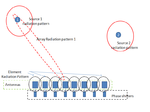akhilpaulv
Full Member level 2
- Joined
- Apr 20, 2013
- Messages
- 136
- Helped
- 7
- Reputation
- 14
- Reaction score
- 7
- Trophy points
- 1,298
- Location
- Thrissur, India
- Activity points
- 2,051
Hi all,
In the below image shows a phased antenna array act as receiver. The source 1 and source 2 transmitting simultaneously. Array pattern 1 generated by phase shifters. My doubt is there will be one potential generated by source 1 in all the antennas elements if we consider the generated potential is x1’. There will another potential y1’ generated by all the antennas due to source 2. Will that potentials adds together(x1’+y1’) and generate a junk data? . In actual case it’s not happening , Will somebody you explain the physics behind its ?
Akhil
In the below image shows a phased antenna array act as receiver. The source 1 and source 2 transmitting simultaneously. Array pattern 1 generated by phase shifters. My doubt is there will be one potential generated by source 1 in all the antennas elements if we consider the generated potential is x1’. There will another potential y1’ generated by all the antennas due to source 2. Will that potentials adds together(x1’+y1’) and generate a junk data? . In actual case it’s not happening , Will somebody you explain the physics behind its ?
Akhil
